|

Early Colt Police Positive Serial Number 403841 with 5"
barrel - Factory inscribed "Inspector Dance Halls" with
blue finish and medallion checkered walnut grips. This
Police Positive was a single gun shipment to W. Bingham
Company on May 20, 1931. It was processed on Colt
Factory Order number 10043/1. Letter confirms factory
inscription "Insp. of Dance Halls" on the strap.
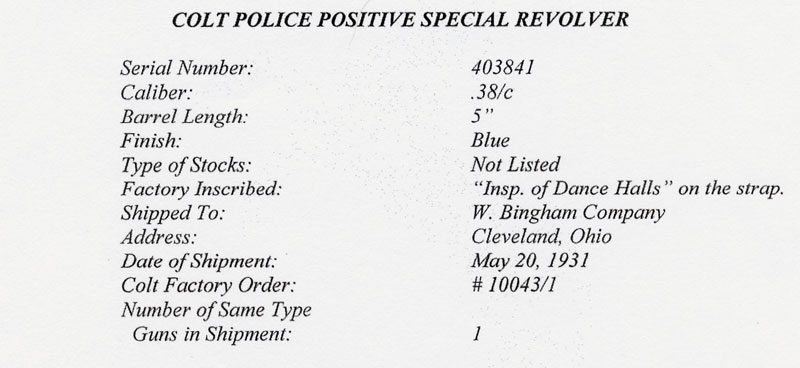

Left side of barrel marked:
| P |
olice
ositive |
-.38 SPECIAL |
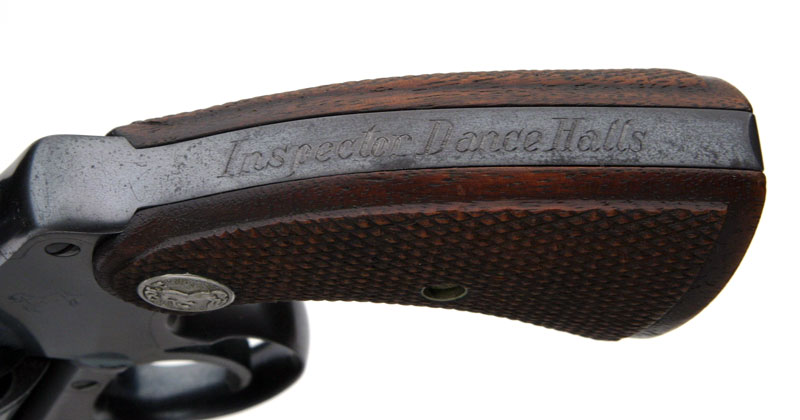
Colt Police Positive .38 Special - factory inscribed
"Inspector Dance Halls" on the rear grip strap.
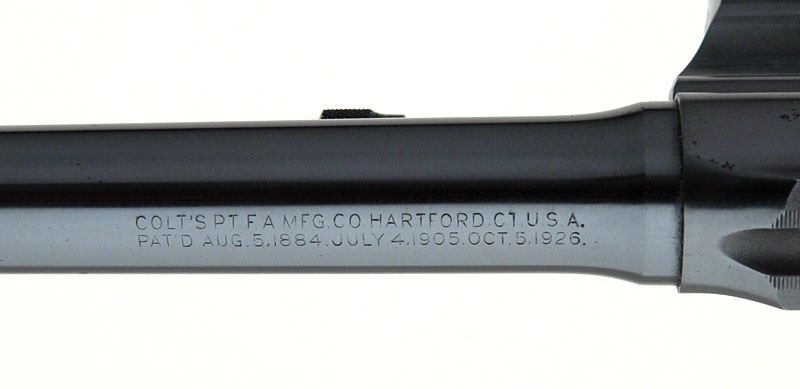
Marked on top of barrel:COLT'S PT. F.
A. MFG. CO. HARTFORD. CT. U.S.A.
PAT'D. AUG. 5, 1884, JULY 4, 1905, OCT. 5, 1926
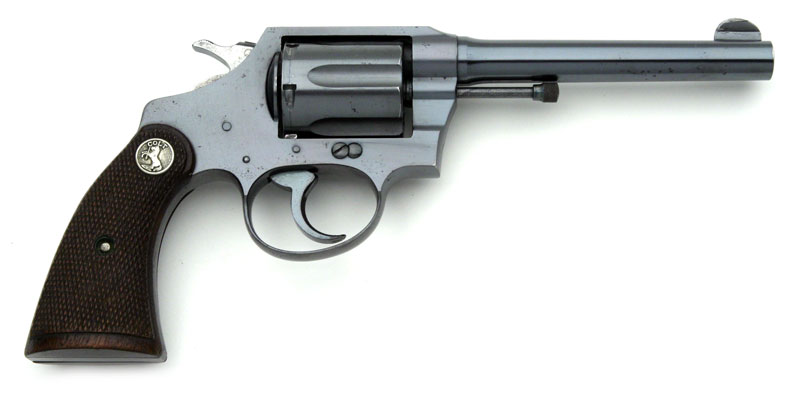
Police Positive .38 Factory Inscribed serial number
403841
with 5" barrel - right side. Revolver is fitted with
Colt factory flush medallion checkered walnut grips. Front
site is standard early rounded type.
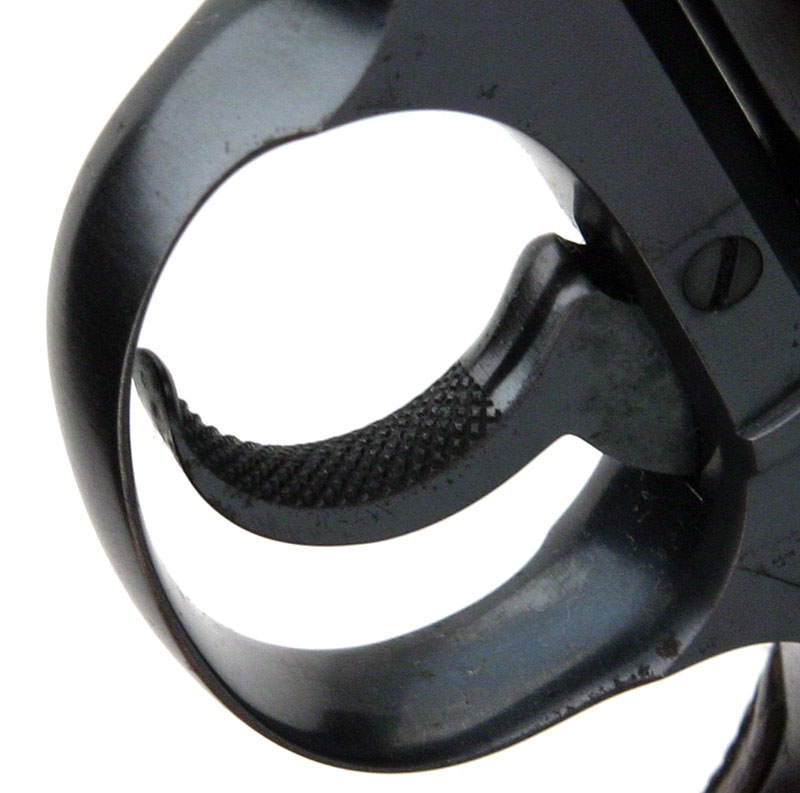
Close-up photo of the checkered trigger (Colt refers to this
as a "checked trigger.")
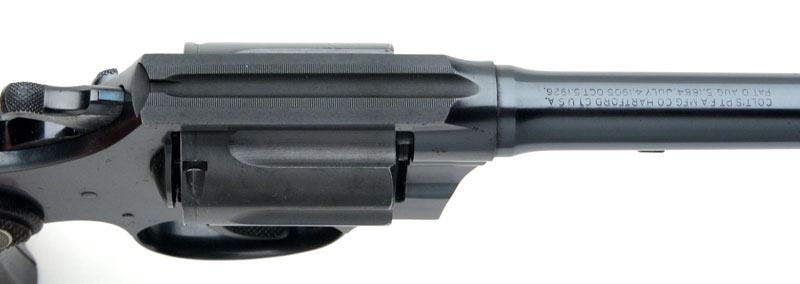
Top view of hammer, frame and barrel.
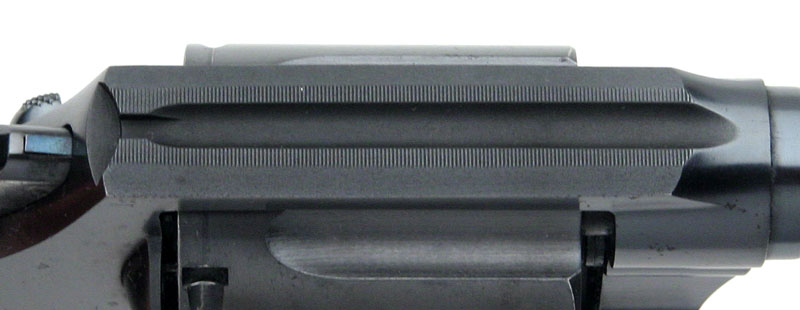
Close-up of top of frame.
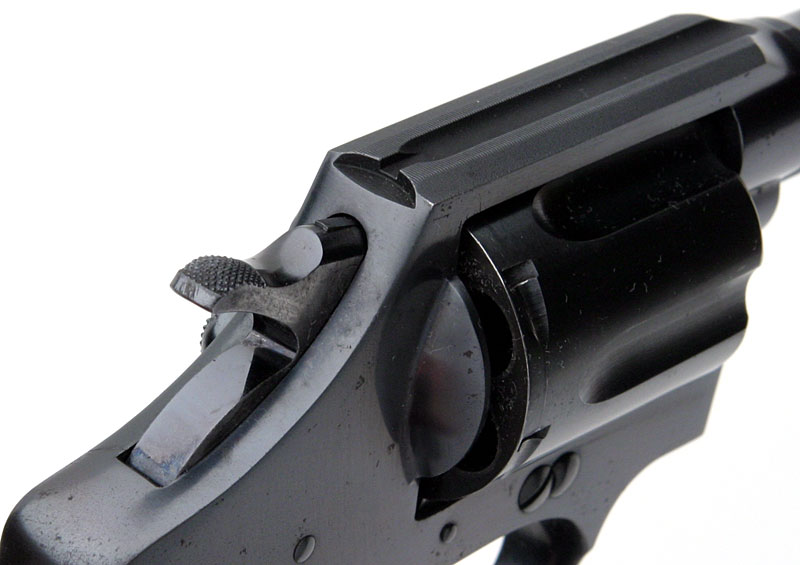
View of the rear of the hammer and frame.
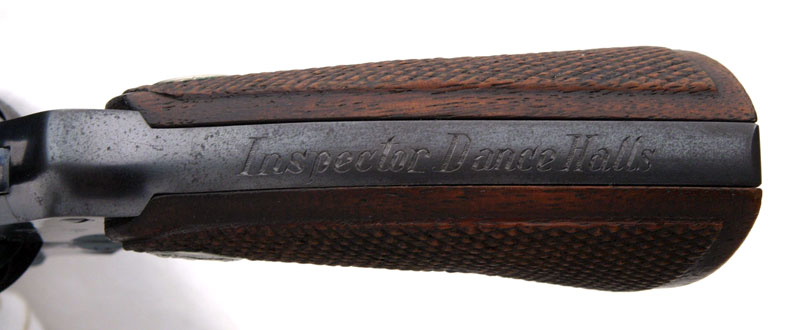
DANCE HALLS - The Encyclopedia of Cleveland History
DANCE HALLS. During much of the 20th century, social dancing
was one of the major recreational activities in industrial
cities such as Cleveland. During the peak years between the
1920s and the 1950s, there were over 150 dance halls
accessible to Greater Clevelanders, not including several
hundred more dance floors in HOTELS, nightclubs, and private
halls. These included facilities extending to Conneaut Lake
Park, PA, in the east; Meyers Lake Park, Canton, in the
south; and Cedar Pt. Park, Sandusky, in the west. Although
cities such as New York, Chicago, and Los Angeles had larger
facilities, Cleveland became well known to musicians and
bandleaders as a place to develop with a chance to move into
a position of national prominence. One of the earliest
social dances in Cleveland was held at Ballow's Hall in
1854. Dances at that time included the two-step, the waltz,
and later the cakewalk and other syncopated steps. By 1910
popular sheet music started to appear with parts for
dance-band instrumentation, and by that time dancing became
viewed as an adjunct to other activities such as swimming
and sports; several dance pavilions were built at parks
built in the early 1900s. At EDGEWATER PARK, a dance
pavilion overlooked a bath house on the beach below. GORDON
PARK had a dance area in conjunction with a large bath house
extending over the lake near E. 72nd St., and a park
building at Brookside, off Fulton and Denison Ave., included
a dance area on the 2nd floor. Another city pavilion was
located at Woodland Hills Park, at Kinsman and Woodland
avenues. The city pavilions were out of existence by the
mid-1920s. Private AMUSEMENT PARKS opened at this time also
offered dancing, in addition to a variety of other
activities suited to families and group outings. Those with
dance floors included White City at E. 140th and Lakeshore;
LUNA PARK, where the dance pavilion was of generous size,
with the dance floor at ground level; EUCLID BEACH PARK,
which had one of the finest dance floors in the region and
which for a time offered outdoor dancing; and PURITAS
SPRINGS PARK, which had a plain ballroom and also featured
an outdoor dance area.
The society dance craze, influenced by the popularity of
Irene and Vernon Castle, led during the World War I period
to a changing social pattern. Before this time, dance halls
were not always considered proper places for members of
polite society; therefore, dances were generally private
functions. Some of the more affluent and prominent citizens
built their homes with a ballroom and party facility,
generally on the 3rd floor, with access by special stairs or
elevator. On the lower end of the social scale, saloons
offered some dancing. Saloon dance floors disappeared after
the 18th Amendment, the Volstead Act, took effect in 1920.
They were replaced during Prohibition by supper clubs with a
more, sophisticated atmosphere that reflected the influence
of society dancing. Some places violated the Volstead Act
while maintaining an atmosphere of prohibition. Most hotels
countrywide included ballrooms or party rooms to provide for
dancing as well as other group activities. Many local hotels
created their own special clubs, with guests of the hotel as
potential clientele. Radio broadcasts originated from hotel
supper clubs on a regular basis during the 1930s and 1940s,
with some broadcasts carried on a national network,
publicizing both the orchestra and the hotel. Numerous
private clubs and fraternal organizations provided a hall in
their building suitable for dances as well as other
organizational functions.
With the increased popularity of dancing in the 1910s and
1920s, many localities enacted laws to regulate conduct in
the dance halls, which were viewed by some citizens as
potential havens for moral laxness between the sexes. By
1930 28 states and 60 large cities had adopted laws or
ordinances to regulate public dancing; Cleveland developed
Ordinance 690, defining regulations for dance places and
dancers. Public Dance Hall meant any academy, room, place,
restaurant, or nightclub where dancing was held, or any
room, place, hall, or academy in which classes in dancing
were held or instruction in dancing was given for a fee. The
ordinance included restrictions on intoxicating liquor and
gambling and required decorum of behavior and dress. Smoking
was restricted to designated rooms. Dance hall inspectors
were first hired by the city in 1929 to check places covered
by the ordinance. By 1930 there were nearly 150 dance-hall
inspectors covering the city. Dance halls also had an
employee assigned to check decorum and dress. Dancing too
close or cheek to cheek was discouraged. After a marathon
dance contest held at the Old Taylor Bowl, at E. 36th St.
and Harvard, the city ordinance was amended to prohibit such
activities. Dance-hall activity in Cleveland reached a peak
during the Big Band era of the 1930s and 1940s. Many of the
major ensembles of that era, including those of Glenn Miller
and Tommy Dorsey, played at locations in the Greater
Cleveland area. However, interest in ballroom dancing
declined through the 1950s as musical tastes changed, and
other forms of entertainment such as TELEVISION became
available. Ballroom and club owners experienced a rise in
operating expenses and increased fees for bands. That, along
with diminishing attendance, especially in some urban areas
where social unrest brought a few roving gangs to disrupt
dances, forced many operations to close or cut back their
schedules. Owners changed their halls from dancing to party
centers, roller rinks, bowling lanes, or a variety of
commercial enterprises.
Although some dance halls existed during the 1800s, most of
Greater Cleveland's most prominent, non-park facilities were
built between 1900-30. The ARAGON, 3179 W. 25th St., was the
last surviving ballroom within Cleveland, until it finally
expired in 1993. It was originally built in 1919 as the
Olympic Winter Garden, catering to dances, roller skating,
banquets, weddings, and prizefights; ownership changed in
1930, and the name became Shadyside Gardens. Several years
later, after remodeling, the ballroom was renamed the
Aragon, after one of Chicago's finest ballrooms. The Crystal
Slipper, 9810 Euclid Ave., opened in 1924 as the largest and
finest of the city ballrooms. Within several years the name
was changed to the Trianon, after another famous ballroom in
Chicago. This dance floor could accommodate 4,000 persons.
Dances were held nightly, and popular name bands were
featured for a night or short-term engagement. During the
early 1940s, the Trianon, under new ownership, became the
Trianon Bowling Lanes, which operated through the 1950s,
when the property was acquired by the CLEVELAND CLINIC
FOUNDATION; the building was razed to become a parking area.
Danceland, 9001 Euclid Ave., operated as a dance hall with
summer roof garden through the 1920s and 1930s, when, under
new ownership, it was converted to a roller rink and renamed
Skateland. By the 1960s, new owners converted and remodeled
the building for commercial use as a food store and other
shops.
The Ritz, 3705 Euclid Ave., was active as a roller rink
through the 1930s, with the name changing to the Greystone
and later to the Marcane, until the structure was given over
to commercial use in the 1950s. Later the entire block,
including the Cleveland Arena, was demolished. Bedford
Glens, located off Glen Rd. in BEDFORD, began as a park in
the early 1900s; soon a barnlike structure was built, and it
became a year-round dance and bowling resort. Although the
ballroom was successful, a fire closed it in 1944.
SPRINGVALE BALLROOM AND COUNTRY CLUB, 5871 Canterbury Rd.,
NORTH OLMSTED, was still operating in the 1990s. It was
built in 1923 by the Biddulph family, who managed it
throughout its history. This ballroom was remodeled on at
least 2 occasions, and in the 1990s dances were held four
nights a week. Only a few dance halls continued to operate
in the 1990s, and these averaged fewer than 2 nights of
dances per week. Hotels, clubs, and fraternal organizations
continued to hold special dances: one restaurant, Swingos at
the Statler, regularly scheduled Sunday brunches with
dancing, capitalizing on a revival of interest in Big Band
music during the 1980s. However, despite predictions of a
revival of ballroom dancing and music, such activities
continued only at a minor level in the 1990s when compared
to their peak period of popularity during the 1930s and
1940s.
Robert Strasmyer |